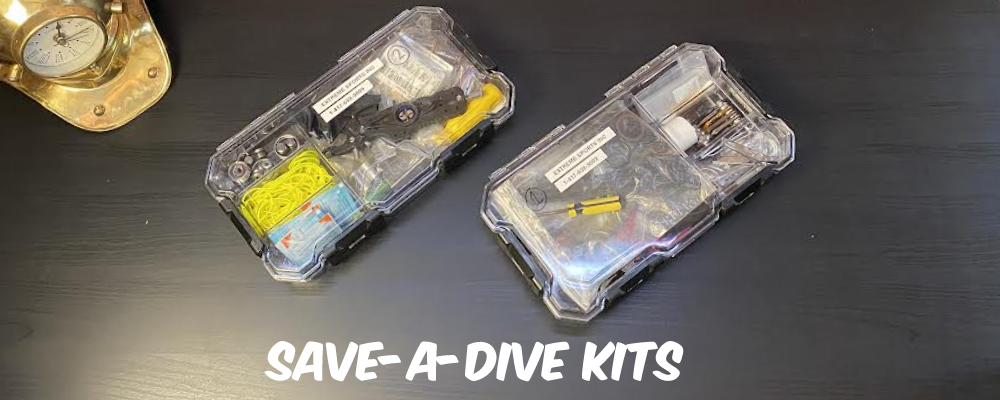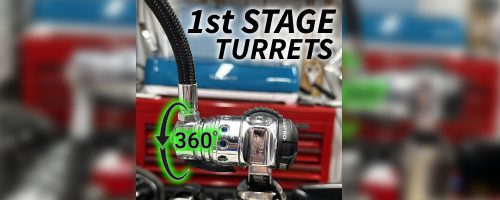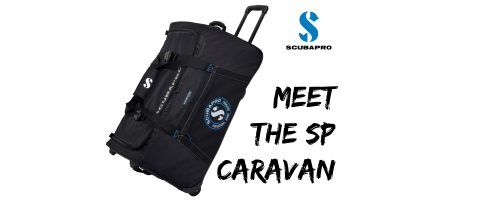“My tank o-ring is missing.” This is the most common ‘failure’ every diver will encounter at least one point in their life while setting up their gear. Save-a-Dive Kits (or SADs as we call them) are something the majority of divers forget to add to the items they pack and take with them to the lake or even on a dive trip. The whole point of this is to Save the Dive! It is an awful feeling when traveling hours to get to a dive site just for a mouthpiece to be ripped. Obviously not every single Open Water SCUBA diver needs to have the most overkill kit with all the items necessary to perform a complete service on their gear. However, a basic Scuba Diver Kit can run about $50-$100 and contains all the necessary items to replace mouthpieces, tank o-rings, batteries, hoses, and maybe even a bad o-ring on a LP swivel.
On the market, there are many options to buy a pre-made SAD kits. While this might work for some, it is not tailored to the majority of divers. All of our gear is configured to our liking and contains different parts and pieces than others. For example, most SAD kits come with an industry ‘standard’ mask strap. This only works on half of the masks on the market anymore and would just be added weight when traveling. We’re going to discuss how to start a kit, what container to use, and the tools/parts you might need to perform certain tasks for your gear.
to start: create a list of your gear
The next time your dive gear is drying out from a day of diving, get out a notebook and create a list of all the dive gear you own. On this list it should include information such as size, style, and any additional add-ons created to your personalized gear. For example, my list would include things such as:
– MK25BT w/ A700 (R195 octo) (Smart + Pro Transmitter / CR2 Battery) (DIN)
– Hydros Pro w/ Air 2 (Men’s Large)
– 2 Nova 850 Tec Lights (C batteries)
I have a list of every single item I own with additional descriptions on the end (like shown above). When building a Save-A-Dive, I can use this list and gather the items I need for my SAD. For my Regulator, I might need some low pressure & high pressure plugs, a battery for my transmitter, and a DIN to Yoke adapter. I will do this with all the items I have and make a list of the items that should be in my kit.
the basics
These are the items we suggest all of our students start gathering for a personal save-a-dive kit:
– Waterproof box (we will cover next)
– 5/32″ allen wrench (for 1st stage plugs)
– 9/16 open end and 5/8 open end wrench
– Low profile crescent wrench
– Flat head and ‘cross point’ screwdriver (smaller)
– EMT shears
– Defogger (duh)
– Nail clippers (for cutting zipties flush)
– Duct tape
– Mouthpiece(s)
– Small amount of nylon line (to tie bolt snaps)
– Zip ties
– Mask and fin straps
– Computer straps
– Batteries (computers, transmitters, flashlights, cameras, strobes, etc.)
– O-ring kit (available in store – personalized for your gear)
– Silicone grease
– O-ring pick
– Bolt snaps
These are the basics of what every save-a-dive kit must have to perform simple repairs on the fly. If you’re questioning your ability to perform these repairs, I highly recommend taking the SDI Equipment Specialist course. This course is designed to give a more in-depth look at how dive equipment works. It will cover general repairs and maintenance of various types of exposure suits, BCD’s, regulators, computers, and other accessories.
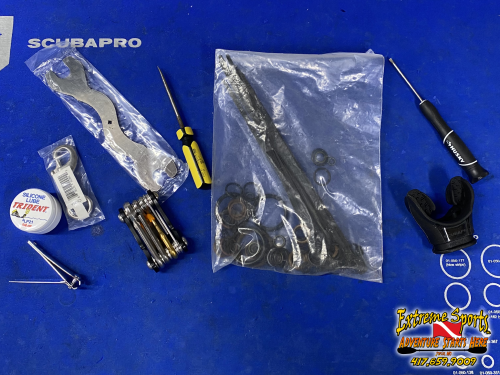
a waterproof box
This is going to be our container that holds all of our tools and equipment. Pick up a container that has an o-ring seal that creates a watertight boundary from the outside elements. I’ve seen so many save-a-dive kits that are just ruined by the amount of rust inside. When this happens, batteries corrode, straps become brittle, and most importantly: it will cost money to replace those items.
Personally, I have some husky boxes that I picked up from a local hardware store. It has a nice seal, dividers, and multiple latches. Geckobrands also makes an affordable box (medium and large) that has a seal with two latches. These are available in-store at Extreme Sports.
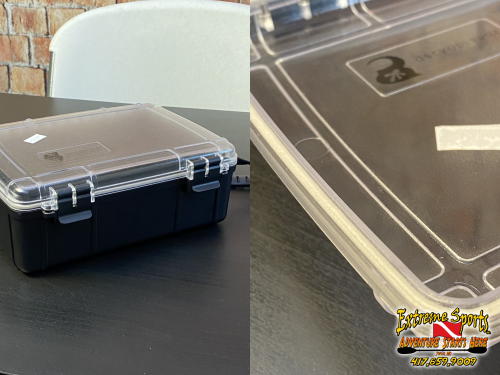
tools
If we didn’t have the tools, we wouldn’t be able to repair our gear. There is a term in diving that should be used in EVERY aspect: KISS – Keep It Stupid Simple… or as some say: Keep It Simple, Stupid!
Compact tools are a great choice for a SAD, especially when traveling. The XS Scuba multi-tool (#1 below), contains most of the necessary items to perform minor repairs. It contains allen keys to remove plugs / DIN inserts, as well as screw drivers, and a brass o-ring pick. (Of course there is a bottle opener too!)
The Divers Wrench set is also another fantastic option for your kit. It contains multiple open ended wrenches that are proper in size but compact to get between hoses and transmitters to remove them from a 1st stage. They’re also compact for reducing the overall size of your SAD! (#2 below)
**Don’t forget to rinse and dry tools after use to prevent corrosion / rust**
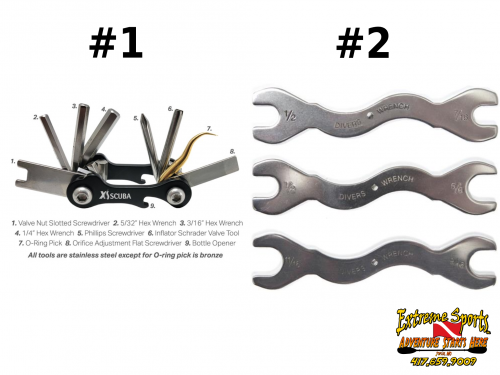
specialty items
Dry suits, cameras, lights, computers, transmitters, etc. are our ‘specialty’ items. For me, my save-a-dive kit contains extra dry suit seals (#1 below) that I can replace if one tears. Flashlights contain o-rings that need to be lubricated (#2 below), so I have spare o-rings and silicone dedicated for each light.
All computers and transmitters are going to contain different batteries, and sometimes even proprietary. I carry a CR2 battery for my Scubapro Smart + Pro, and yes, I have had to replace it while out of the country. My previous battery only lasted about 4 months; however, I understand that every battery is going to be different and you can’t rely on battery manufactures to manufacture them the same. This is where the SAD comes in!
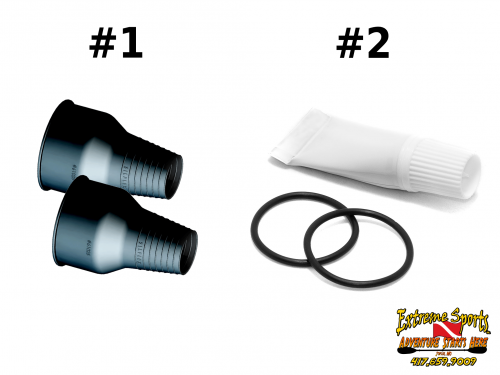
additional items
These are the items you might consider adding to your SAD:
EarShield
Small punches (to replace straps)
Motion Sickness Medicine
Sunscreen
Camera o-rings
First Aid Kit (Check out my blog post about this subject)
For any questions or concerns, leave a comment below. We would love to hear your opinions!
other blog posts:
Selecting the Right SCUBA Mask
it’s just important! What is the most important piece of...
Read MoreTop Gifts for Scuba Divers
Our List Scuba divers always have a need for something...
Read More1st Stage Turrets – Why?
Jumping back in history Looking back in time at Scubapro’s...
Read MoreMeet the Scubapro Caravan Bag
before the caravan Through out the years I have traveled...
Read More